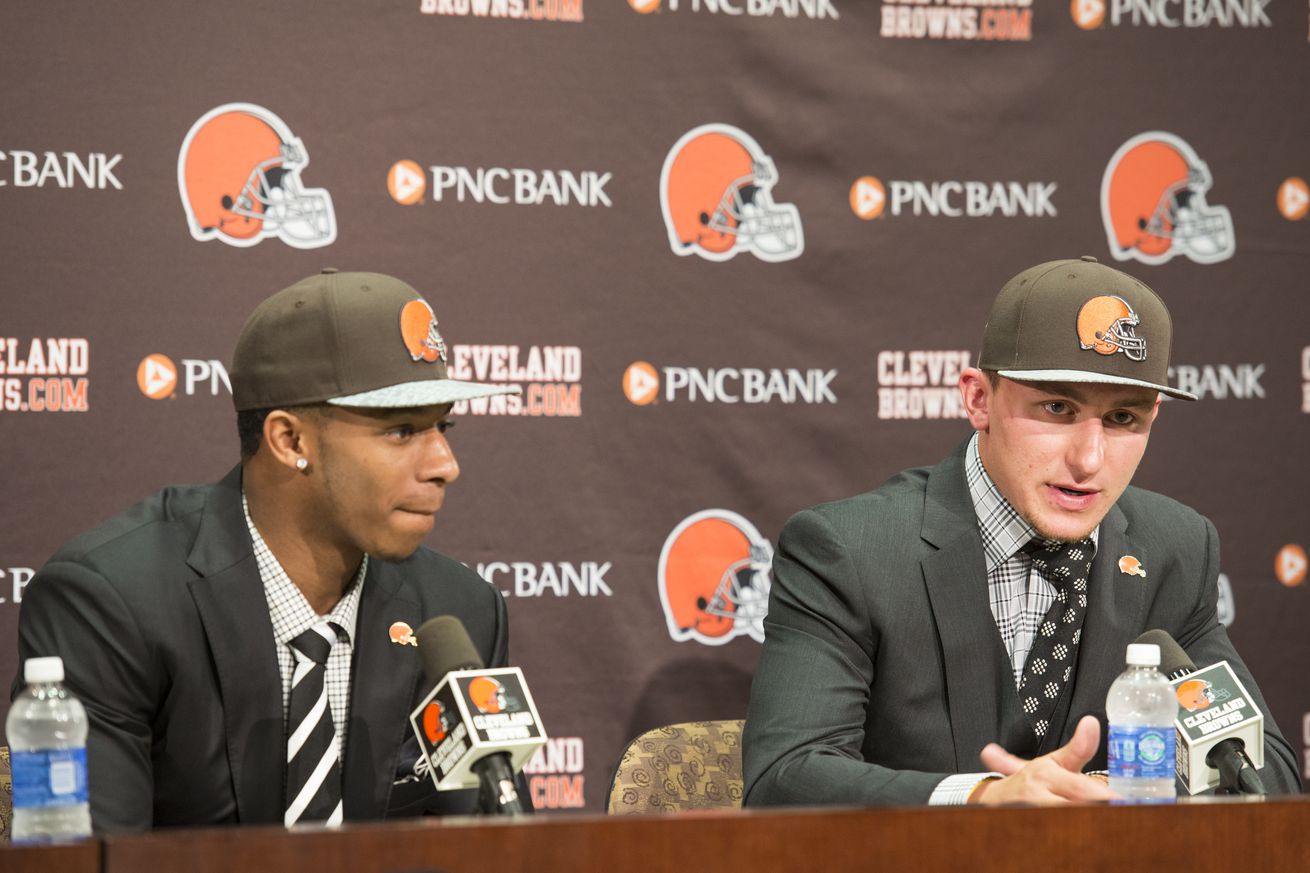
Avoidable mistakes were made 10 years ago, but franchise has dug itself out of the rubble to be a playoff contender.
The Cleveland Browns braintrust headed into the 2014 NFL Draft in a solid position to improve a roster that had won just 27 games over the previous six seasons.
The bungling front office of Joe Banner and Michael Lombardi were out, replaced by general manager Ray Farmer. The team also had a new head coach in Mike Pettine, who hoped to build a foundation of accountability and competitiveness after the revolving door of Rob Chudzinski, Pat Shurmur, and Eric Mangini in the head coach’s office.
Related: NFL Draft factors unknown to the public that impact prospects’ stock
The stage was set for Farmer to have a franchise-altering draft with two selections in the first round – No. 4 and No. 26 overall – and a second-round selection at No. 35 overall.
It ended up being franchise-altering, but not in the way that Farmer, Pettine, and owner Jimmy Haslam imagined. But, from the rubble of that lost weekend 10 years ago, it also helped set the stage for a roster with legitimate playoff aspirations in 2024.
As was typical, the Browns headed into the 2014 draft in need of a quarterback after seeing enough of Brandon Weeden. As luck would have it, that year’s draft class did not include a quarterback worthy of being selected high in the first round, a lesson the Jacksonville Jaguars learned after selecting Blake Bortles at No. 3 overall.
But there were a few offensive players that would have made a quarterback’s life easier, such as wide receivers Mike Evans or Odell Beckham Jr. There were also defensive players that would have helped, including linebacker Khalil Mack – a player that Pettine enthused about – and defensive tackle Aaron Donald.
/cdn.vox-cdn.com/uploads/chorus_asset/file/25409869/457117190.jpg)
Photo by Jason Miller/Getty Images
Unfortunately, Farmer decided to flex his muscles by trading down from No. 4 to No. 9, then trading back up to No. 8 to select cornerback Justin Gilbert, a player that many teams were concerned about and that Pettine had not met before the draft.
Not content with making just one mistake in the first round, Farmer, with a boost from Haslam, traded up four spots in the first round to No. 22 to select quarterback Johnny Manziel, who will likely hold the title of worst first-round pick in franchise history for decades to come.
The tape, in fact, can lie
The Manziel selection is one example of how teams consistently make up their minds about a player and refuse to change their mind despite all evidence to the contrary. In a recent article in The Athletic about why teams consistently bungle the draft, Steve Gera, who was working in 2013 as a special assistant to Chudzinski, shared an example of that cognitive bias regarding Manziel:
That’s what led (Gera) to Cleveland, where, on a plane at the beginning of the 2013 season, he says he heard a Browns executive say, “The only person I’ve seen who competes harder than Johnny Manziel is Michael Jordan.”
“What makes you say that?” Gera asked.
“Tape,” the executive said. “Watch it long enough, and you’ll see it, too.”
Compare a prospect to a legend from the outset, and you — or, say, Browns owner Jimmy Haslam, who drafted Manziel at No. 22 overall and then watched as the quarterback’s career imploded suddenly and spectacularly — are likely to cling to that early comparison despite evidence to the contrary.
Manziel would flame out after two seasons and eight starts with the Browns, taking down Farmer and Pettine along the way.
That opened the door for Hue Jackson to stake his undisputed claim as the worst coach in NFL history, along with the exhausting analytics war as new general manager Sashi Brown, along with current general manager Andrew Berry, worked to bring the Browns into the modern era of roster building that an overwhelming majority of NFL teams had already embraced.
/cdn.vox-cdn.com/uploads/chorus_asset/file/25409874/1171033637.jpg)
Photo by Jason Miller/Getty Images
Brown gave way to general manager John Dorsey and his love of “real football players,” while Jackson was followed as head coach by another one-year wonder in Freddie Kitchens. The situation finally stabilized in 2020 with Berry as general manager and Kevin Stefanski as head coach, a pairing that has produced two playoff seasons in four years and hopes of even more in the future.
Despite all the turmoil in the front office and on the sidelines, there were successes, including Bitonio, Myles Garrett, Nick Chubb, and Denzel Ward; and misses, including trading for Beckham, and drafting more wide receivers who failed to make an impact that seems possible.
So what is the point of all this?
First off, it highlights the major impact of missing out on the quarterback position.
The Manziel disaster restarted Cleveland’s quarterback carousel of Josh McCown, Austin Davis, Cody Kessler, Robert Griffin III, Kevin Hogan, Charlie Whitehurst, DeShone Kizer, and Tyrod Taylor.
It looked like the Browns had finally found their answer with Baker Mayfield only to see that fall apart, which in turn led them to Deshaun Watson, who still has questions surrounding his game after surgery on his throwing shoulder.
History, however, rarely lies
The second point is that, despite all the work that teams invest, it is hard to successfully draft players.
Teams allocate an enormous amount of resources to determine which players they will select, from countless hours scouting, evaluating, and meeting with players prior to the draft, to the money spent on salaries for the players, which in 2023 ranged from $37.9 million in guaranteed money for Bryce Young, the first player selected, to $77,776 in guaranteed money for Desjuan Johnson, the final player selected.
/cdn.vox-cdn.com/uploads/chorus_asset/file/25409876/531295348.jpg)
General managers also want their bosses and fans to believe they have unlocked the secret to drafting good players, yet they continue to miss more than they hit on players, with six traits coming into play, according to The Ringer’s Sheil Kapadia:
- Overrating their ability to evaluate talent
- Ignoring historical evidence to justify a selection (Be wary of selecting a tight end in the first round.)
- Overrating that a prospect will make an immediate impact (More than 62 percent of drafted rookies played fewer than 300 snaps their first season over the past five drafts.)
- Believing the previous year’s draft class impacts this year’s draft (Houston Texans quarterback C.J. Stroud and Los Angeles Rams wide receiver Puka Nacua are the exception for rookies, not the norm.)
- Believing your coaching staff can unlock a player’s hidden potential
- Choosing the “best player available” over positional value (quarterbacks are more important than centers)
That last bullet item regarding positional value may be the most important one on the list.
In 2022, Darren O’Donoghue at The 33rd Team looked at positional value for players drafted in the years 2010 to 2017 through the lens of which positions are more likely to earn a second contract from the team that drafted them.
O’Donoghue found that offensive linemen achieve almost 10 times more guaranteed money on a second contract, with defensive back, defensive tackle, and tight end rounding out the top group. On the lower end of the scale are inside linebackers and running backs, positions that have fallen out of favor in the modern NFL.
According to O’Donoghue, this information can help teams with long-term planning by revealing which positions are more likely to earn a second contract from a team, which assists in setting priorities about which positions to target each year in the draft.
Despite all this information, it is almost a guarantee that a few general managers will make one or more of these easily avoidable mistakes later this week when the draft is held in Detroit. Hopefully, Berry will not be one of those general managers.
/cdn.vox-cdn.com/uploads/chorus_asset/file/25409877/1494896558.jpg)
Photo by Nick Cammett/Getty Images
The past few decades have not been kind to the Browns. Much of that has been their own doing, but there is still a human element to talent evaluation that can’t be measured by a chart, things such as desire, how well a player responds to coaching (and the quality of the coaching they will receive), injuries, and how much a player still wants to compete once they are paid.
It has been a decade since Ray Farmer fell into the trap that has ensnared so many other general managers during draft weekend, both before and since his forgettable night in 2014. While it can be argued that Farmer’s mistakes were avoidable, that lost weekend in New York ultimately set the Browns on a path to where they are now a legitimate playoff contender.
Writer and philosopher George Santayana wrote, “Those who cannot remember the past are condemned to repeat it.” The current Browns front office appears to be one that remembers the past, so hopefully they can continue to avoid repeating it when it comes to evaluating players.


















You must be logged in to post a comment Login